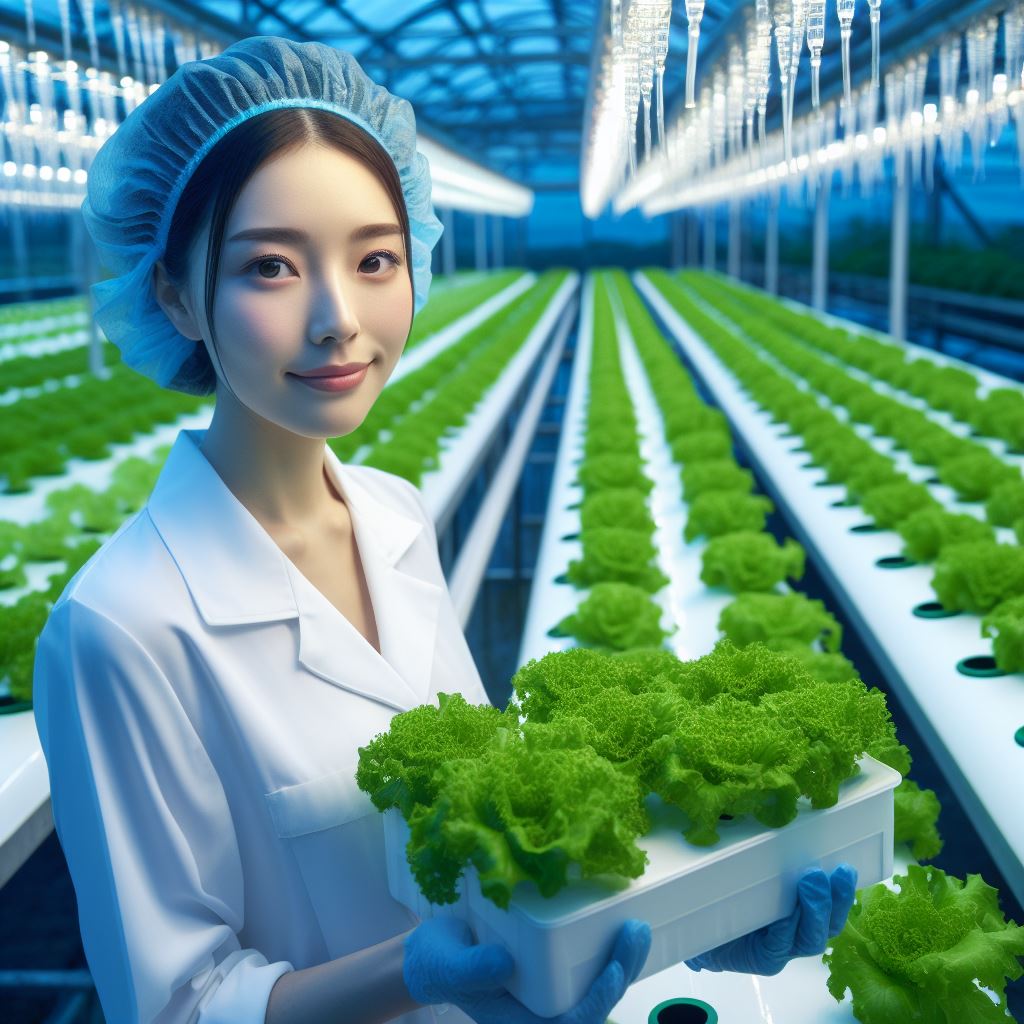Introduction
Let’s explore Climate Resilient Urban Farming.
Definition of Urban Farming
Urban farming refers to the practice of cultivating food or raising animals within an urban environment.
Importance of Climate Resilience
Climate resilience plays a crucial role in urban farming as it allows for the sustainable production of food despite changing climate conditions.
Urban farms that are resilient to climate change can adapt and continue to provide fresh produce to local communities.
Urban farming has gained popularity in recent years as more people recognize its potential to address food security issues, especially in densely populated urban areas.
By growing food locally, urban farming reduces the reliance on long-distance transportation and minimizes carbon emissions associated with the industrial food system.
Moreover, urban farming contributes to climate resilience by promoting biodiversity.
By cultivating various crops and utilizing different farming techniques, urban farmers create resilient ecosystems that can withstand extreme weather events, pests, and diseases.
The importance of climate resilience in urban farming extends beyond food production.
Urban farms provide green spaces that improve air quality, reduce the urban heat island effect, and offer recreational opportunities.
These benefits contribute to the overall well-being and resilience of urban communities.
In general, urban farming is not only a solution to food security but also a means to build climate resilience in the face of climate change.
By integrating sustainable practices and adapting to changing conditions, urban farmers are at the forefront of creating a more resilient and sustainable food system for cities.
Benefits of Urban Farming
Urban farming offers numerous benefits ranging from environmental to social and economic.
Let’s explore each of these benefits in detail.
Transform Your Agribusiness
Unlock your farm's potential with expert advice tailored to your needs. Get actionable steps that drive real results.
Get StartedEnvironmental Benefits
- Reduction in greenhouse gas emissions: Urban farming helps combat climate change by reducing the carbon footprint associated with transportation, which is necessary for food grown in rural areas to reach urban markets.
- Conservation of biodiversity: By creating green spaces and promoting the growth of various plant species, urban farming supports the preservation of biodiversity in urban areas. It provides habitats for different types of insects, birds, and other wildlife.
- Improvement of air and water quality: Through the process of photosynthesis, plants absorb carbon dioxide and release oxygen, contributing to cleaner and healthier air. Additionally, urban farming helps filter rainwater, preventing urban runoff and improving water quality.
Social Benefits
- Increased access to fresh and nutritious food: Urban farming plays a crucial role in addressing food insecurity by providing communities with easy access to locally grown, fresh produce. This helps improve dietary diversity and promotes better nutrition.
- Promotion of healthy lifestyles: By cultivating fresh food within urban areas, urban farming encourages individuals to incorporate more fruits and vegetables into their diets. It also promotes physical activity as gardening and maintaining urban farms involve physical exertion.
- Creation of job opportunities: Urban farming is a potential source of employment, especially for individuals residing in urban areas with limited job prospects. It creates opportunities for community involvement and training in agricultural practices, leading to skill development and income generation.
Economic Benefits
- Lower transportation costs and carbon footprint: Growing food in urban areas reduces the need for long-distance transportation, resulting in lower transportation costs and carbon emissions. This also enhances food security during times of disruptions in transportation networks.
- Utilization of unused urban spaces: Urban farming transforms vacant lots, rooftops, and underutilized spaces into productive agricultural areas. This optimizes land use and minimizes urban sprawl while maximizing the potential for food production in limited urban areas.
- Support for local economy: By buying locally grown food, individuals support urban farming initiatives and contribute to the growth of the local economy. Urban farms create a market for local produce, stimulating entrepreneurship and fostering the development of a sustainable food system.
Generally, urban farming offers a range of benefits, including environmental conservation, improved social well-being, and economic development.
By embracing urban farming practices, communities can enhance their resilience to climate change while fostering a sense of community and self-sufficiency.
Read: Agroforestry: Combining Trees and Crops
Urban Farming Techniques for Climate Resilience
Urban farming techniques are crucial for building climate resilience in increasingly urbanized environments.
As cities expand and face the challenges posed by climate change, implementing sustainable and efficient farming practices becomes essential.
Vertical Farming
Vertical farming is a technique that allows food to be grown in vertically stacked layers.
This innovative approach enables efficient space utilization, which is particularly valuable in densely populated urban areas where land is limited.
By utilizing unused vertical spaces in buildings, such as walls or multi-story structures, vertical farms can significantly increase food production capacity.
In addition to optimizing space, vertical farming also addresses water scarcity concerns.
Many vertical farms utilize hydroponic systems, where plants are grown without soil and receive their required nutrients through water solutions.
Compared to traditional agriculture, vertical farming uses up to 90% less water due to its closed-loop irrigation systems.
By recirculating water, losses due to evaporation, runoff, or deep percolation are minimized.
Vertical farms are also better protected against extreme weather conditions.
By being housed indoors, crops are shielded from storms, hail, and temperature extremes.
This protection ensures consistent crop yields and reduces the risk of crop failure due to unpredictable climate events.
These indoor structures further allow for precise control over light, temperature, and humidity, creating optimal growing conditions for the plants.
Hydroponics
Hydroponics is a soilless farming technique that involves growing plants in nutrient-rich water solutions.
This method conserves water resources while enabling year-round cultivation.
Traditional soil-based agriculture requires a substantial amount of water to hydrate the plants and keep the soil fertile.
In contrast, hydroponics allows plants to take in water and nutrients more efficiently, reducing water consumption significantly.
Moreover, hydroponics provides a controlled environment for crops, allowing for uninterrupted cultivation regardless of the season.
This year-round production helps meet the demand for fresh produce consistently and reduces the reliance on importing food from distant regions.
By minimizing transportation distances, hydroponics also decreases greenhouse gas emissions associated with food transportation, thus contributing to climate change mitigation.
Additionally, hydroponic systems can effectively reduce the reliance on pesticides.
Showcase Your Farming Business
Publish your professional farming services profile on our blog for a one-time fee of $200 and reach a dedicated audience of farmers and agribusiness owners.
Publish Your ProfileIn controlled environments, pest infestations can be managed through integrated pest management strategies without the need for excessive chemical interventions.
By reducing chemical inputs, hydroponics promotes healthier and more sustainable food production.
Aquaponics
Aquaponics combines aquaculture (fish farming) and hydroponics to create a mutually beneficial system.
Fish waste, which contains valuable nutrients, is used as fertilizer for plant growth in hydroponic beds.
The plants, in turn, filter and purify the water, creating an efficient nutrient-cycling system.
This symbiotic relationship between fish and plants eliminates the need for synthetic fertilizers and minimizes the discharge of fish waste into the environment.
Aquaponics enhances ecosystem resilience by creating a balanced and self-regulating system.
The integration of fish and plants promotes biodiversity and creates a more stable ecosystem.
The efficient use of nutrients leads to higher crop yields and reduces the environmental impact caused by conventional agricultural practices.
Therefore, urban farming techniques such as vertical farming, hydroponics, and aquaponics offer promising solutions to improve climate resilience in cities.
By maximizing space, conserving water, reducing reliance on pesticides, and enhancing nutrient cycling, these techniques promote sustainable and efficient food production in urban environments.
Implementing these techniques on a larger scale can contribute to building more climate-resilient cities and ensuring food security in a changing climate.
Read: Farming in 2050: Water Management Innovations

Policy and Community Support
Urban farming has gained significant attention in recent years as a climate-resilient solution to various challenges faced by urban areas.
With limited space and increasing urbanization, traditional agriculture methods no longer suffice to meet the growing food demands of cities.
However, with proper policy support and community involvement, urban farming can bring about numerous benefits, both environmental and social.
Incentives for Urban Farming
To encourage urban farming practices, governments should consider implementing various incentives.
Tax benefits can be offered to individuals and businesses engaged in urban farming, providing them with financial relief.
Additionally, grants and financial assistance programs should be established to support the initial setup costs and operational expenses of urban farming initiatives.
Such financial aid can enable aspiring urban farmers to invest in necessary infrastructure, tools, and resources.
Furthermore, zoning regulations and land use policies must be reevaluated to accommodate urban farming.
Cities should designate specific areas for urban agricultural activities and develop guidelines to ensure effective land allocation.
By incorporating urban farming into land use policies, cities can optimize land utilization and promote food self-sufficiency.
Education and Awareness
Promoting sustainable farming practices plays a crucial role in the success of urban farming.
Public education programs should focus on teaching urban dwellers about eco-friendly farming methods suitable for limited spaces.
By emphasizing efficient use of resources, such as water conservation techniques and organic pest control, urban farmers can minimize their environmental impact and contribute to sustainability.
Community engagement is vital in urban farming efforts.
Encouraging the establishment of community gardens and shared farming spaces not only provides access to fresh produce but also strengthens social bonds and fosters a sense of belonging.
Community gardens promote collaboration, knowledge sharing, and skills development among participants, creating a supportive network for urban farmers.
Public outreach campaigns can further enhance awareness of urban farming benefits.
These campaigns should aim to educate communities about the positive impact of urban farming on local food security, public health, and environmental conservation.
Empowering individuals with knowledge about the advantages of urban farming will encourage wider adoption and support for this sustainable practice.
Collaboration and Partnerships
Effective collaboration between various stakeholders is crucial for the success of urban farming initiatives.
Governments should forge partnerships with NGOs and local organizations to leverage their expertise and resources.
This collaboration can facilitate project implementation, knowledge sharing, and capacity building, thereby accelerating the adoption of urban farming practices.
Urban planning departments play a vital role in promoting urban farming.
By incorporating urban agriculture into city development plans, planners can allocate suitable land and infrastructure to support farming activities.
Integrating urban farming into urban planning strategies will ensure its long-term sustainability and its integration into the fabric of the city.
Encouraging cooperation between farmers and consumers is another essential aspect of urban farming.
Farmers’ markets and community-supported agriculture (CSA) models establish direct relationships between producers and consumers.
Showcase Your Farming Business
Publish your professional farming services profile on our blog for a one-time fee of $200 and reach a dedicated audience of farmers and agribusiness owners.
Publish Your ProfileThese models not only facilitate the distribution of fresh, locally grown produce but also establish a sense of trust and connection between urban farmers and the urban population.
Lastly, policy support and community engagement are critical elements in facilitating the widespread adoption of urban farming.
Incentives, education, and collaboration can collectively drive the shift toward climate-resilient agriculture, ensuring food security, environmental sustainability, and stronger communities in our urban centers.
Read:Biochar Usage: Farmers’ Weapon Against CO2
Success Stories and Case Studies
Urban Farming Initiatives in New York City
New York City has witnessed a significant increase in local food production through urban farming initiatives.
Community gardens, rooftop farms, and hydroponic systems have become increasingly popular.
Urban farming has had a positive social impact on communities in New York City.
These initiatives bring people together, foster community engagement, and promote a sense of belonging.
Furthermore, urban farming in New York City has generated positive economic outcomes.
It has created jobs, entrepreneurship opportunities, and local economic growth, contributing to the city’s overall prosperity.
Impact of Urban Farming in Chicago
Urban farming initiatives in Chicago have significantly improved food security and access to fresh, healthy produce.
Local communities now have a sustainable source of nutritious food.
Chicago’s urban farming practices have played a crucial role in mitigating the effects of climate change.
By sequestering carbon dioxide, reducing food miles, and utilizing sustainable farming techniques, these initiatives have minimized environmental impact.
Another significant outcome of urban farming in Chicago is its contribution to the city’s resilience in the face of extreme weather events.
The presence of green spaces helps absorb excess rainwater, reducing flooding risks.
These success stories and case studies from New York City and Chicago demonstrate the immense potential of urban farming.
Aside from promoting local food production, urban farming initiatives have had a transformative impact on communities.
Furthermore, the economic benefits derived from urban farming contribute to the overall well-being of the cities and their residents.
Moreover, in both cities, urban farming has proven to be an effective strategy for combating climate change.
From reducing greenhouse gas emissions to enhancing resilience in the face of extreme weather events, these initiatives play a vital role in building climate resilience.
Overall, these success stories and case studies highlight the importance of urban farming as a climate-resilient shift.
They serve as inspiration for other cities to embrace similar initiatives and contribute to a more sustainable and resilient future.
Read: Tech in Agri: Saving Water Amidst Climate Woes
Conclusion
Recap of benefits and techniques discussed
Urban farming offers numerous benefits and techniques that can contribute to a climate-resilient future.
Through the practice of growing food in urban areas, communities can reduce their carbon footprint, improve food security, and enhance biodiversity.
Some of the techniques discussed include rooftop gardens, vertical farming, and hydroponics, which maximize limited space and conserve water resources.
These practices not only provide fresh produce but also create a green and sustainable environment.
Importance of climate-resilient farming
Climate-resilient farming is of utmost importance as we face the challenges of climate change and urbanization.
It serves as a solution to mitigate the impacts of extreme weather events, such as floods or droughts, and promotes sustainable land use.
Call to action for individuals and communities to support urban farming for a more climate-resilient future
To ensure a more climate-resilient future, individuals and communities need to take action and support urban farming initiatives.
This can be done by advocating for policies that encourage and facilitate urban farming, volunteering in local community gardens, or even starting rooftop gardens or small-scale farms in urban areas.
By coming together and embracing urban farming, we can create a more resilient and sustainable future, where agriculture is integrated into the fabric of our cities and contributes to climate change adaptation and mitigation efforts.




